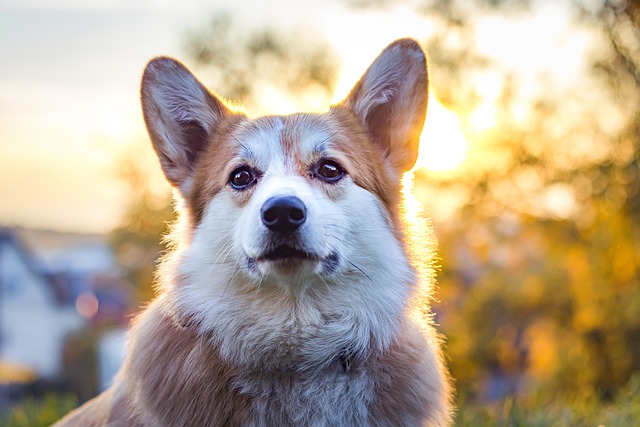
What is glaucoma in a dog?
You might notice your dog squinting more at mealtime or avoiding bright sunlight—these small changes could be early signs of a serious eye condition.
When you welcome your dog at home with joy, it is like a furry little angel, bringing endless joy to life. And taking care of its diet and daily life has become an important part of daily life. Among them, how to determine whether the dog is full is a concern for every owner. This is not only related to the health of dogs, but also carries our full love for them.
Dogs cannot express whether they are full or not through words, so we need to observe and judge from multiple aspects. Firstly, it is crucial to pay attention to the state of the dog while eating. When food is placed in front of a dog, if it wolfs it down at first, it means it is indeed hungry. But as the eating process progresses, if its speed gradually slows down, it is no longer as eager as it was at the beginning, and even begins to pick and choose, this may be a signal that it is almost full. For example, some dogs start by taking big bites of dog food and then slowly chew one by one as they eat, even picking out flavors they don't like. At this point, it's time to consider reducing the feeding amount.
The condition of the dog's abdomen is also an important criterion for judgment. Before eating, a dog's abdomen is usually relatively flat. After it is full, its abdomen will slightly bulge, but not too swollen. We can gently touch the dog's abdomen with our hands to feel it. If we feel that the abdomen is soft and slightly bulging, like a balloon full of air but not too hard, it means that the dog is eating just right. However, if the abdomen feels hard to the touch and even shows obvious swelling, it is likely that the dog has been overfed, which may cause discomfort and even the risk of vomiting.
Observing the behavior of dogs after meals can also provide a lot of information. Dogs who are well fed and drunk are usually more satisfied and relaxed, and may find a comfortable place to lie down and rest, or play leisurely. For example, after meals, it will slowly walk to its own nest, lie down and take a nap, or play with toys on its own. On the contrary, if a dog continues to surround you after a meal, wagging its tail or even scratching you with its paws, making urgent calls, it is likely that it has not eaten enough and hopes that you can give it some more food.

Dogs of different ages also exhibit varying levels of satiety. Puppies have a small stomach capacity and grow rapidly, requiring small meals and frequent meals. After they are full, they may not immediately calm down like adult dogs, because puppies are energetic and still full of vitality even if they are full. But if the puppy becomes restless and frequently licks dishes after eating, it may be because they haven't eaten enough yet. However, the appetite and digestive ability of elderly dogs will decrease, and their eating speed will be slower, with relatively less food intake. If an elderly dog quickly stops eating and is no longer interested in food, even if there is still food in the bowl, do not force it to continue eating, as this may be a sign that it is already full.
In addition to these intuitive observations, changes in a dog's weight are also important indicators for determining whether it is full. Regularly weigh the dog, and if the weight steadily increases within the normal range, it indicates that the dog's dietary intake is reasonable. But if the weight continues to increase, even overweight, then it is necessary to reflect on whether it has been fed too much; On the contrary, if the weight keeps decreasing and the dog looks increasingly thin, it may be due to insufficient food intake and the need to increase the feeding amount appropriately.
Dogs are our most loyal companions, and their health touches our hearts. Judging whether a dog is full is an important task in the process of taking care of them. We need to observe every detail of dogs with patience and attention to detail, and use scientific methods to adjust their diet. Every time we feed our dogs, it is a transmission of love, and we hope to see them eat healthily and happily. Let us wholeheartedly accompany the growth of dogs, pay attention to their dietary needs, and in this process, our relationship with dogs will become deeper and deeper. In the days to come, watching our dog live a healthy and happy life under our careful care will be our happiest moment.

You might notice your dog squinting more at mealtime or avoiding bright sunlight—these small changes could be early signs of a serious eye condition.

Let’s set the scene: It’s a sweltering Phoenix afternoon—105°F outside—and you rushed your 2-year-old Lab mix, Cooper, on a quick walk to “get it over with.”

Let’s get real: You’re in your Miami apartment, watching your 3-year-old Corgi, Loki, struggle to climb the stairs to your second-floor unit.

Many dog owners brush off occasional scratching as just “dog behavior,” but persistent itching often signals something more—like a food allergy.

You might first notice your dog scratching more than usual—chewing at their paws until the fur looks thin, or rubbing their face against the couch nonstop.

Let’s be real: You’re standing in your Chicago apartment, watching your 3-year-old Beagle, Max, huff and puff just to climb onto the couch.